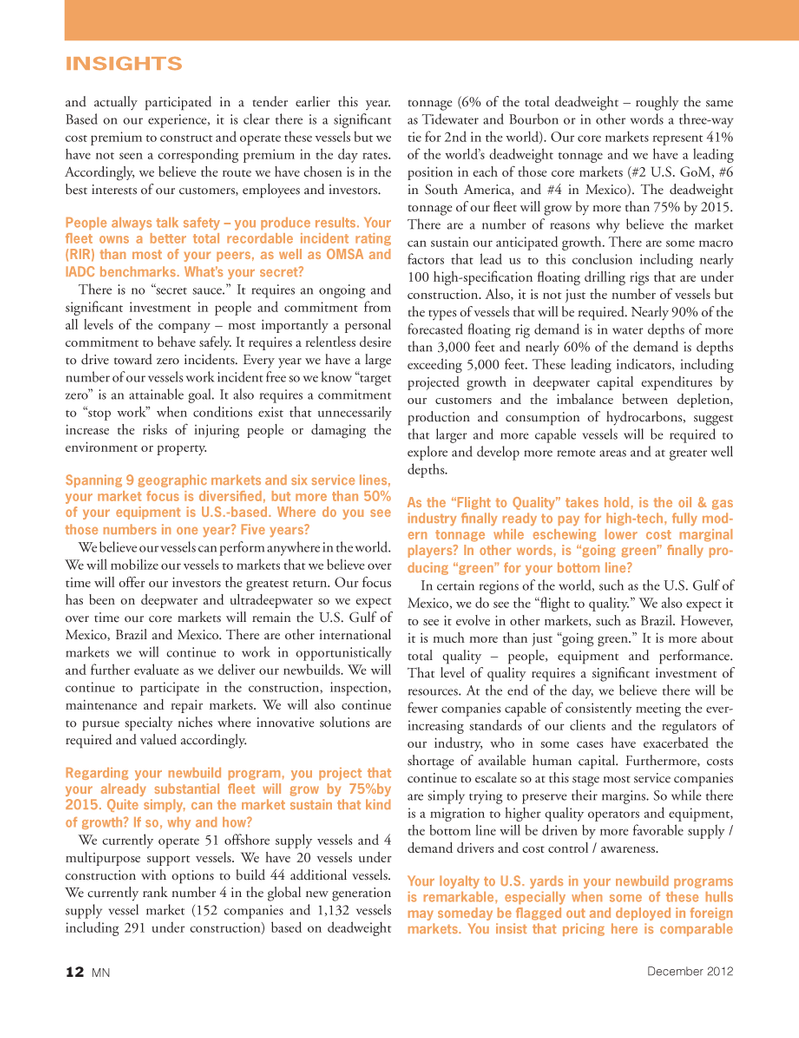
Page 12: of Marine News Magazine (December 2012)
Innovative Products &
Read this page in Pdf, Flash or Html5 edition of December 2012 Marine News Magazine
INSIGHTSand actually participated in a tender earlier this year. Based on our experience, it is clear there is a signiÞ cant cost premium to construct and operate these vessels but we have not seen a corresponding premium in the day rates. Accordingly, we believe the route we have chosen is in the best interests of our customers, employees and investors. People always talk safety ? you produce results. Your eet owns a better total recordable incident rating (RIR) than most of your peers, as well as OMSA and IADC benchmarks. What?s your secret? There is no Òsecret sauce.Ó It requires an ongoing and signiÞ cant investment in people and commitment from all levels of the company Ð most importantly a personal commitment to behave safely. It requires a relentless desire to drive toward zero incidents. Every year we have a large number of our vessels work incident free so we know Òtarget zeroÓ is an attainable goal. It also requires a commitment to Òstop workÓ when conditions exist that unnecessarily increase the risks of injuring people or damaging the environment or property. Spanning 9 geographic markets and six service lines, your market focus is diversi ed, but more than 50% of your equipment is U.S.-based. Where do you see those numbers in one year? Five years?We believe our vessels can perform anywhere in the world. We will mobilize our vessels to markets that we believe over time will offer our investors the greatest return. Our focus has been on deepwater and ultradeepwater so we expect over time our core markets will remain the U.S. Gulf of Mexico, Brazil and Mexico. There are other international markets we will continue to work in opportunistically and further evaluate as we deliver our newbuilds. We will continue to participate in the construction, inspection, maintenance and repair markets. We will also continue to pursue specialty niches where innovative solutions are required and valued accordingly. Regarding your newbuild program, you project that your already substantial eet will grow by 75%by 2015. Quite simply, can the market sustain that kind of growth? If so, why and how? We currently operate 51 offshore supply vessels and 4 multipurpose support vessels. We have 20 vessels under construction with options to build 44 additional vessels. We currently rank number 4 in the global new generation supply vessel market (152 companies and 1,132 vessels including 291 under construction) based on deadweight tonnage (6% of the total deadweight Ð roughly the same as Tidewater and Bourbon or in other words a three-way tie for 2nd in the world). Our core markets represent 41% of the worldÕs deadweight tonnage and we have a leading position in each of those core markets (#2 U.S. GoM, #6 in South America, and #4 in Mexico). The deadweight tonnage of our ß eet will grow by more than 75% by 2015. There are a number of reasons why believe the market can sustain our anticipated growth. There are some macro factors that lead us to this conclusion including nearly 100 high-speciÞ cation ß oating drilling rigs that are under construction. Also, it is not just the number of vessels but the types of vessels that will be required. Nearly 90% of the forecasted ß oating rig demand is in water depths of more than 3,000 feet and nearly 60% of the demand is depths exceeding 5,000 feet. These leading indicators, including projected growth in deepwater capital expenditures by our customers and the imbalance between depletion, production and consumption of hydrocarbons, suggest that larger and more capable vessels will be required to explore and develop more remote areas and at greater well depths.As the ?Flight to Quality? takes hold, is the oil & gas industry nally ready to pay for high-tech, fully mod- ern tonnage while eschewing lower cost marginal players? In other words, is ?going green? nally pro- ducing ?green? for your bottom line? In certain regions of the world, such as the U.S. Gulf of Mexico, we do see the Òß ight to quality.Ó We also expect it to see it evolve in other markets, such as Brazil. However, it is much more than just Ògoing green.Ó It is more about total quality Ð people, equipment and performance. That level of quality requires a signiÞ cant investment of resources. At the end of the day, we believe there will be fewer companies capable of consistently meeting the ever- increasing standards of our clients and the regulators of our industry, who in some cases have exacerbated the shortage of available human capital. Furthermore, costs continue to escalate so at this stage most service companies are simply trying to preserve their margins. So while there is a migration to higher quality operators and equipment, the bottom line will be driven by more favorable supply / demand drivers and cost control / awareness. Your loyalty to U.S. yards in your newbuild programs is remarkable, especially when some of these hulls may someday be agged out and deployed in foreign markets. You insist that pricing here is comparable 12 MNDecember 2012

 11
11

 13
13
